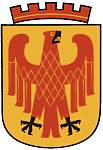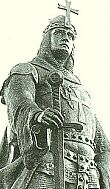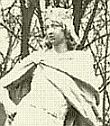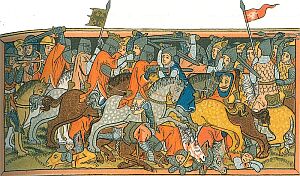
Für eine deutsche Übersetzung dieser Seite einfach die Brandenburger Flagge anklicken
 |
Click the Brandenburg Flag for a German translation Für eine deutsche Übersetzung dieser Seite einfach die Brandenburger Flagge anklicken |


 |
Home Towns - Potsdam, GermanyPotsdam's Rulers throughout the Centuries1157 - 1320 |
 |


 |
This site is part of our Potdam, Germany site. Click the left turn sign to get back to the Potsdam start site. |


 History is not made by individuals, but by people. However, the history made by the people is often associated with the rulers of the time. Here is a list of those who took credit and blame for Potsdam's history. We are not trying to compete with Wikipedia's comprehensive list of Rulers of Brandenburg although we have been trying to fill in some blanks here and there. Biographical references are generally limited to events affecting Potsdam and/or Brandenburg. The dates under the names don't refer to birth and death but rather to the time in office. Blue links lead to sites with more information, in most cases to a Wikipedia article. In some cases, we couldn't find an article in English language; in this case, Green links lead to articles in German language.
|
 |
Click the left-turn sign to get back to the previous section. Or, if you are interested in a different time period, click the U-turn sign to get to the "Rulers" start page. |
 |


 
|
Albert the Bear 1157-1170  On June 11, 1157, Albert fought a last bloody battle, breaking Wendish resistance for good. Ever since, this date is celebrated as the birthday of the Brandenburg Margraviate and on October 3, 1157, Albert called himself Margrave for the first time.  At the time, he only ruled the land along rivers Havel and Nuthe, but shortly after defeating Jacza, Albert extended his realm and invited settlers from neighboring countries. Amongst those who came were Dutch who lost their land in heavy floods. They were experienced dike builders and soon started regulating rivers Havel and Elbe, reclaiming new land for settlements.
|
 Wikipedia Biography
Wikipedia Biography
|
 
|
Otto I of Brandenburg 1170-1184  Since 1144, Albert ruled together with his son, Otto I who was born around 1128. (Not to be confused with the first German Emperor of the same name). After Albert's death in 1170, Otto officially received the title Margrave. In Addition, he received the title of Archchancellor in 1177. One year after that, in 1178, Pomeranian Duke Casimir invaded the March. Otto defeated the invader in 1180, extending his rule past the Tollense River. In the same year, he had the March's first Abbey built in Lehnin. Here he was buried in 1184.
|

|
 
|
Otto II of Brandenburg 1184-1205  Otto II followed his father Otto I on the Brandenburg Throne. Under his rule, the province experiences substantial growth. Otto II undertook successful campaigns against his Slavonic neighbors and against Danish King Canute VI. In the winter of 1198/99, he raided Danish-occupied Pomerania and consolidated his territorial gains the year after with a campaign that pressed all the way to the island of Rügen.  After his death, his younger brother Albert II took the szepter.
|

|
 
|
Albrecht II 1205-1220  From 1189 to 1192, during the reign of Otto II, his younger brother Albert took part in the Third Crusade. In 1198, in Acre, in the Holy Land, he was one of the founding members of the Order of the Teutonic Knights.  Otto II and Albert II didn't always see eye to eye and in 1194, Otto even had his brother imprisoned for a while. But nevertheless, after Otto's death in 1205, Albert took the Throne. He further contributed to the territorial growth of the province, adding the regions of Teltow and Prignitz and parts of the Uckermark.
|

|
 
|
Johann I & Otto III 1220-1266/67  Next to Albert the Bear, his grand-grandsons John (born about 1213) and Otto the Pius (born 1215) were the most famous members of the House of Ascania. The two sons of Albert II shared the Brandenburg Throne and history reports that their relationship was always a harmonious, brotherly one.  The brothers extended the territory of the March further east, incorporating the remaining parts of Teltow and the Uckermark, as well as Barnim, Stargard, Lubusz and - for the first time - parts of the land east of River Oder. They also consolidated Brandenburg's stand in domestic, German politics - in 1256, Otto III was one of the candidates to be elected as the next German King.  Otto and John are hailed as founders of Berlin. They also turned other former hamlets like Cölln, Spandau, Frankfurt/Oder and Prenzlau into fortified towns. The Spandau Citadel was the brothers' preferred residence. |

|
 |
 John died in 1266 and Otto ruled for one more year as the single Margrave. Before their death, the brothers divided Brandenburg's authority into an "Ottonian" and a "Johannian" line. Their children continued this trend and at a time there were up to ten brothers and cousins sharing the Throne. Official Prussian history only acknowledges John's oldest son Otto IV as Margrave, while his brothers John II, Conrad I and Henry I are listed as co-rulers of Brandenburg-Stendal and his cousins (Otto III's sons) John III, Otto V, Otto VI and Albert III are called co-rulers of Brandenburg-Salzwedel. If you like puzzles, you can sort it all out at Wikipedia. |

 
|
Otto IV 1266-1308  After the death of John I, his son Otto IV (born around 1238) became the ruler of Brandenburg-Stendal; his brothers John II, Conrad I und Henry I were co-rulers. In 1267, Otto III's son John III, Otto V, Otto VI und Albert III became co-rulers of Brandenburg-Salzwedel.  Otto's time as Margrave was marked by the "Second Ascanian War." After the death of Arch Bishop Conrad II, Otto tried to install his youngest brother Eric as successor. This move was heavily opposed by the town of Magdeburg, home of the late Arch Bishop Conrad II.  In 1278, Magdeburg's troops defeated Otto in a battle near Frohse (today Schönebeck/Elbe). Otto and 300 of his knights were captured, Otto himself was put in a cage and displayed in Magdeburg. |

|
 |
After Otto paid
4,000 pounds of silver for his release, he continued the war but was defeated again in 1280 near Staßfurt. During that battle, he was hit by an
arrow which was then stuck to his head for over a year, earning him the nickname Otto with the Arrow. He had to fight for three more years
until he was finally successful and installed Eric as the new Brandenburg Arch Bishop, thus ending the war in his favor.
 Later, he too contributed to the territorial growth of Brandenburg, acquiring the Palatinate Saxony in the Saale-Unstrut Region and the Margraviate of Landsberg (both in 1292) and the March of Lusatia (in 1303).
|

 
|
Waldemar the Great 1308-1319  Waldemar, a son of Otto's brother and co-ruler Conrad was born around 1280. He became ruler of Brandenburg-Stendal after the death of Otto IV. During his reign, he acquired Züllichau and Schwiebus; but at the same time, he turned over Pomerelia and Danzig to the Order of the Teutonic Knights for a paiment of 10,000 Silver Marks. In 1316 he supported the north German town Stralsund in a battle against Denmark. As a result, he found himself facing a powerful coalition of Denmark, Sweden, Poland, Mecklenburg and the Welfs. He stood his ground, but in the end, he had to surrender Stargard to Mecklenburg.  The other part of the March, Brandenburg-Salzwedel was ruled by Hermann the Long- a son of Otto V - until 1308 and then by Hermann's son John the Illustrious until 1317. In 1309, Waldemar married John's sister Agnes. In 1317, John died without leaving a heir and with that, both parts of Brandenburg were reunited under Waldemar's rule. However, the might of the Ascanians was fading.
|

|
 
|
Henry the Child 1319-1320  Waldemar didn't have any children of his own. When Henry I - a brother and co-ruler of Otto IV - died in 1318, Waldemar became the guardian of Henry I's son, Henry II, born in 1308 and made him his heir. Henry II was only 11 years old, when Waldemar died in 1319. His new guardian was Rudolph of Saxony, also a descendent of the House of Ascania.  Many neighboring rulers tried to gain influence on the 11 year-old boy on the throne of Brandenburg, but Henry's premature death just a year later put an end to these attempts. The following seven years were marked by a power struggle between Henry's guardian Rudolph, Duke of Saxony from the House of Ascania and German Emperor Louis IV from the House of Wittelsbach.
|
  Wikipedia Biography
Wikipedia Biography
|
 
 
|
King and Counter King 1314-1322  The Brandenburg line of the House of Ascania ended with Henry's premature death. After that, the March was again under direct control of the German Emperor. However, the situation in the Empire at the time wasn't any less complicated than the situation in Brandenburg.  In 1313, Emperor Henry VII of the House of Luxembourg died of Malaria. The King's election in the following year ended in a standoff and eventually, the rivaling parties decided to elect not one, but two kings. |
  Battle at Mühldorf, 1322 |
 |
On October 19, 1314, the Archbishop of Cologne crowned Frederick the Fair from the house of Habsburg as King of the Germans. But only one day later, the Archbishop of Mainz crowned Counter King Louis the Bavarian from the House of Wittelsbach. It took until 1322 to violently settling the matter. At the Battle at Mühldorf, Louis achieved a decisive victory over his rival and became sole King. Eventually in 1328 he was crowned Emperor of the Germans. |

 
|
The Houses of Wittelsbach and Luxembourg 1320-1415  For 170 years, Brandenburg was ruled by the Ascanians. The end of the Ascanian line ushered in a hundred years of turmoil and unrest, while the province was governed by rulers living hundreds of miles away. First, in 1323, a German King from the Bavarian House of Wittelsbach secured the province for his family, enfeoffing it to his son.  Then, fifty years later, another King, this time from the house of Luxembourg, did the same for his son and his family. All the while, the true rulers of the country were local noblemen, better known as Robber-Barons. |


 |
Click the right-turn sign to continue to Part 3 of our
Potsdam's Rulers Through the Centuries site, covering the Margraves of Wittelsbach (1320-1373) and Luxembourg (1373-1415). Or click the u-turn sign to returne to the "Rulers" start site. |

|


 Back to Potsdam Page |
 Back to Home Towns |
 Back to Germany Page |
 Back to English Main Page |
 Back to Start Page |